Short-Term Effects of the EU Nitrate Directive Reintroduction: Reduced N Loads to River from an Alluvial Aquifer in Northern Italy
Abstract
:1. Introduction
2. Materials and Methods
3. Results
3.1. Surface- and Groundwater Quantitative Monitoring
3.2. Monitoring of Water Chemistry of Surface- and Groundwater
3.3. Mincio River NO3− Loads
4. Discussion
4.1. Characterization of the NO3− Contamination: Source and Trend
4.2. Transferring of NO3− Contamination from Groundwater to the Mincio River
4.3. The Effects of the Nitrate Directive Fertilization Limits Reintroduction in the Italian NVZ
5. Conclusions
Supplementary Materials
Author Contributions
Funding
Data Availability Statement
Acknowledgments
Conflicts of Interest
References
- Steinfeld, H.; Gerber, P.; Wassenaar, T.; Castel, V.; Rosales, M.; Rosales, M.; de Haan, C. Livestock’s Long Shadow: Environmental Issues and Options; Food & Agriculture Organization: Rome, Italy, 2006. [Google Scholar]
- Steinfeld, H.; Mooney, H.A.; Schneider, F.; Neville, L.E. Livestock in a Changing Landscape, Volume 1: Drivers, Consequences, and Responses; Island Press: Washington, DC, USA, 2013. [Google Scholar]
- Schröder, J. Revisiting the agronomic benefits of manure: A correct assessment and exploitation of its fertilizer value spares the environment. Bioresour. Technol. 2005, 96, 253–261. [Google Scholar] [CrossRef] [PubMed]
- Sims, J.; Bergström, L.; Bowman, B.; Oenema, O. Management. Nutrient management for intensive animal agriculture: Policies and practices for sustainability. Soil Use Manag. 2005, 21, 141–151. [Google Scholar] [CrossRef]
- Bartoli, M.; Racchetti, E.; Delconte, C.A.; Sacchi, E.; Soana, E.; Laini, A.; Longhi, D.; Viaroli, P. Nitrogen balance and fate in a heavily impacted watershed (Oglio River, Northern Italy): In quest of the missing sources and sinks. Biogeosciences 2012, 9, 361–373. [Google Scholar] [CrossRef] [Green Version]
- Cinnirella, S.; Buttafuoco, G.; Pirrone, N. Stochastic analysis to assess the spatial distribution of groundwater nitrate concentrations in the Po catchment (Italy). Environ. Pollut. 2005, 133, 569–580. [Google Scholar] [CrossRef] [PubMed]
- Sacchi, E.; Acutis, M.; Bartoli, M.; Brenna, S.; Delconte, C.A.; Laini, A.; Pennisi, M. Origin and fate of nitrates in groundwater from the central Po plain: Insights from isotopic investigations. Appl. Geochem. 2013, 34, 164–180. [Google Scholar] [CrossRef]
- Perego, A.; Basile, A.; Bonfante, A.; De Mascellis, R.; Terribile, F.; Brenna, S.; Acutis, M. Nitrate leaching under maize cropping systems in Po Valley (Italy). Agric. Ecosyst. Environ. 2012, 147, 57–65. [Google Scholar] [CrossRef]
- Italian National Institute of Statistics. 6th General Census of Agriculture. Available online: http://dati-censimentoagricoltura.istat.it/Index.aspx (accessed on 15 July 2020).
- European Union. Council Directive 91/676/EEC of 12 December 1991 concerning the protection of waters against pollution caused by nitrates from agricultural sources. Off. J. Eur. Communities 1991, 375, 1–8. [Google Scholar]
- European Union. Commission Implementing Decision of 3 November 2011 on granting a derogation requested by Italy with regard to the Regions of Emilia Romagna, Lombardia, Piemonte and Veneto pursuant to Council Directive 91/676/EEC concerning the protection of waters against pollution caused by nitrates from agricultural sources (notified under document C(2011) 7770). Off. J. Eur. Communities 2011, 287, 36–41. [Google Scholar]
- European Union. Commission Implementing Decision (EU) 2016/1040 of 24 June 2016 on granting a derogation requested by Italian Republic with regard to the Regions of Lombardia and Piemonte pursuant to Council Directive 91/676/EEC concerning the protection of waters against pollution caused by nitrates from agricultural sources (notified under document C(2016) 3820). Off. J. Eur. Communities 2016, 169, 6–13. [Google Scholar]
- Lasagna, M.; De Luca, D.A.; Franchino, E. Nitrate contamination of groundwater in the western Po Plain (Italy): The effects of groundwater and surface water interactions. Environ. Earth Sci. 2016, 75, 240. [Google Scholar] [CrossRef]
- Zanini, A.; Petrella, E.; Sanangelantoni, A.M.; Angelo, L.; Ventosi, B.; Viani, L.; Rizzo, P.; Remelli, S.; Bartoli, M.; Bolpagni, R.; et al. Groundwater characterization from an ecological and human perspective: An interdisciplinary approach in the Functional Urban Area of Parma, Italy. Rend. Lincei. Sci. Fis. E Nat. 2018, 30, 93–108. [Google Scholar] [CrossRef]
- Soana, E.; Racchetti, E.; Laini, A.; Bartoli, M.; Viaroli, P. Soil Budget, Net Export, and Potential Sinks of Nitrogen in the Lower Oglio River Watershed (Northern Italy). Clean-Soil Air Water 2011, 39, 956–965. [Google Scholar] [CrossRef]
- Martinelli, G.; Dadomo, A.; De Luca, D.A.; Mazzola, M.; Lasagna, M.; Pennisi, M.; Pilla, G.; Sacchi, E.; Saccon, P. Nitrate sources, accumulation and reduction in groundwater from Northern Italy: Insights provided by a nitrate and boron isotopic database. Appl. Geochem. 2018, 91, 23–35. [Google Scholar] [CrossRef]
- Viaroli, P.; Soana, E.; Pecora, S.; Laini, A.; Naldi, M.; Fano, E.A.; Nizzoli, D. Space and time variations of watershed N and P budgets and their relationships with reactive N and P loadings in a heavily impacted river basin (Po river, Northern Italy). Sci. Total Environ. 2018, 639, 1574–1587. [Google Scholar] [CrossRef]
- Pinardi, M.; Soana, E.; Laini, A.; Bresciani, M.; Bartoli, M. Soil system budgets of N, Si and P in an agricultural irrigated watershed: Surplus, differential export and underlying mechanisms. Biogeochemistry 2018, 140, 175–197. [Google Scholar] [CrossRef]
- Monti, C.; Cipriano, G.; Paleari, M.; Tremolada, L. Stato Delle Acque Sotterranee in Regione Lombardia: Corpi Idrici Sotterranei. Rapporto Sessennale 2014–2019; ARPA Lombardia: Milan, Italy, 2021. [Google Scholar]
- Severini, E.; Bartoli, M.; Pinardi, M.; Celico, F. Reactive Silica Traces Manure Spreading in Alluvial Aquifers Affected by Nitrate Contamination: A Case Study in a High Plain of Northern Italy. Water 2020, 12, 2511. [Google Scholar] [CrossRef]
- Severini, E.; Bartoli, M.; Celico, F. Can’t tell a book by its cover: Disjointed groundwater contamination and land use in an alluvial aquifer of northern Italy. Ital. J. Eng. Geol. Environ. 2021, 1, 229–238. [Google Scholar] [CrossRef]
- Amorosi, A.; Pavesi, M.; Ricci Lucchi, M.; Sarti, G.; Piccin, A. Climatic signature of cyclic fluvial architecture from the Quaternary of the central Po Plain, Italy. Sediment. Geol. 2008, 209, 58–68. [Google Scholar] [CrossRef]
- Monitoraggio Idrografico AIPo. Available online: https://www.agenziapo.it/content/monitoraggio-idrografico-0 (accessed on 8 November 2021).
- Pearson, F. Fixed Endpoint Alkalinity Determination. J. (Water Pollut. Control Fed.) 1981, 53, 1243–1252. [Google Scholar]
- American Public Health, A.; Eaton, A.D.; American Water Works, A.; Water Environment, F. Standard Methods for the Examination of Water and Wastewater; APHA-AWWA-WEF: Washington, DC, USA, 2005. [Google Scholar]
- Golterman, H.L.; Clymo, R.S.; Ohnstadt, M.A.M. Methods for Physical and Chemical Analysis of Freshwaters-1BP Handbook No 8, 2nd ed.; John Wiley & Sons, Ltd.: Hoboken, NJ, USA, 1980; Volume 65, p. 169. [Google Scholar]
- Okamoto, G.; Okura, T.; Goto, K. Properties of silica in water. Geochim. Cosmochim. Acta 1957, 12, 123–132. [Google Scholar] [CrossRef]
- ARPA Lombardy. Archivio Dati Idro-Nivo-Meteorologici Di ARPA Lombardia. Available online: https://www.arpalombardia.it/Pages/Meteorologia/Richiesta-dati-misurati.aspx (accessed on 22 August 2021).
- R Core Team. R: A Language and Environment for Statistical Computing; R Foundation for Statistical Computing: Vienna, Austria, 2020. [Google Scholar]
- Chelli, A.; Zanini, A.; Petrella, E.; Feo, A.; Celico, F. A multidisciplinary procedure to evaluate and optimize the efficacy of hydraulic barriers in contaminated sites: A case study in Northern Italy. Environ. Earth Sci. 2018, 77, 246. [Google Scholar] [CrossRef]
- Goldenberg, L.C.; Magaritz, M.; Amiel, A.J.; Mandel, S. Changes in hydraulic conductivity of laboratory sand-clay mixtures caused by a seawater-freshwater interface. J. Hydrol. 1984, 70, 329–336. [Google Scholar] [CrossRef]
- Kolbjørn Jensen, J.; Engesgaard, P.; Johnsen, A.R.; Marti, V.; Nilsson, B. Hydrological mediated denitrification in groundwater below a seasonal flooded restored riparian zone. Water Resour. Res. 2017, 53, 2074–2094. [Google Scholar] [CrossRef]
- Rotiroti, M.; Bonomi, T.; Sacchi, E.; McArthur, J.M.; Stefania, G.A.; Zanotti, C.; Taviani, S.; Patelli, M.; Nava, V.; Soler, V.; et al. The effects of irrigation on groundwater quality and quantity in a human-modified hydro-system: The Oglio River basin, Po Plain, northern Italy. Sci. Total Environ. 2019, 672, 342–356. [Google Scholar] [CrossRef]
- Rapti-Caputo, D.; Vaccaro, C. Geochemical evidences of landfill leachate in groundwater. Eng. Geol. 2006, 85, 111–121. [Google Scholar] [CrossRef]
- Cuoco, E.; Darrah, T.H.; Buono, G.; Verrengia, G.; De Francesco, S.; Eymold, W.K.; Tedesco, D. Inorganic contaminants from diffuse pollution in shallow groundwater of the Campanian Plain (Southern Italy). Implications for geochemical survey. Environ. Monit. Assess. 2015, 187, 46. [Google Scholar] [CrossRef]
- Federico, C.; Aiuppa, A.; Favara, R.; Gurrieri, S.; Valenza, M. Geochemical monitoring of groundwaters (1998–2001) at Vesuvius volcano (Italy). J. Volcanol. Geotherm. Res. 2004, 133, 81–104. [Google Scholar] [CrossRef]
- Busico, G.; Kazakis, N.; Colombani, N.; Mastrocicco, M.; Voudouris, K.; Tedesco, D. A modified SINTACS method for groundwater vulnerability and pollution risk assessment in highly anthropized regions based on NO3− and SO42− concentrations. Sci. Total Environ. 2017, 609, 1512–1523. [Google Scholar] [CrossRef]
- Steinich, B.; Escolero, O.; Marín, L.E. Salt-water intrusion and nitrate contamination in the Valley of Hermosillo and El Sahuaral coastal aquifers, Sonora, Mexico. Hydrogeol. J. 1998, 6, 518–526. [Google Scholar] [CrossRef]
- Pawar, N.J.; Shaikh, I.J. Nitrate pollution of ground waters from shallow basaltic aquifers, Deccan Trap Hydrologic Province, India. Environ. Geol. 1995, 25, 197–204. [Google Scholar] [CrossRef]
- Panno, S.V.; Hackley, K.C.; Hwang, H.H.; Kelly, W.R. Determination of the sources of nitrate contamination in karst springs using isotopic and chemical indicators. Chem. Geol. 2001, 179, 113–128. [Google Scholar] [CrossRef]
- Woessner, W.W. Stream and Fluvial Plain Ground Water Interactions: Rescaling Hydrogeologic Thought. Groundwater 2000, 38, 423–429. [Google Scholar] [CrossRef]
- Pinardi, M.; Bartoli, M.; Longhi, D.; Marzocchi, U.; Laini, A.; Ribaudo, C.; Viaroli, P. Benthic metabolism and denitrification in a river reach: A comparison between vegetated and bare sediments. J. Limnol. 2009, 68, 133–145. [Google Scholar] [CrossRef]
- Tavernini, S.; Pierobon, E.; Viaroli, P. Physical factors and dissolved reactive silica affect phytoplankton community structure and dynamics in a lowland eutrophic river (Po river, Italy). Hydrobiologia 2011, 669, 213–225. [Google Scholar] [CrossRef]
- Naldi, M.; Viaroli, P. Nitrate uptake and storage in the seaweed Ulva rigida C. Agardh in relation to nitrate availability and thallus nitrate content in a eutrophic coastal lagoon (Sacca di Goro, Po River Delta, Italy). J. Exp. Mar. Biol. Ecol. 2002, 269, 65–83. [Google Scholar] [CrossRef]
- Viaroli, P.; Naldi, M.; Christian, R.R.; Fumagalli, I. The role of macroalgae and detritus in the nutrient cycles in a shallow-water dystrophic lagoon. Int. Ver. Theor. Angew. Limnol. Verh. 1993, 25, 1048–1051. [Google Scholar] [CrossRef]
- Bolpagni, R.; Bresciani, M.; Laini, A.; Pinardi, M.; Matta, E.; Ampe, E.M.; Giardino, C.; Viaroli, P.; Bartoli, M. Remote sensing of phytoplankton-macrophyte coexistence in shallow hypereutrophic fluvial lakes. Hydrobiologia 2014, 737, 67–76. [Google Scholar] [CrossRef]
- Pinardi, M.; Bresciani, M.; Villa, P.; Cazzaniga, I.; Laini, A.; Tóth, V.; Fadel, A.; Austoni, M.; Lami, A.; Giardino, C. Spatial and temporal dynamics of primary producers in shallow lakes as seen from space: Intra-annual observations from Sentinel-2A. Limnologica 2018, 72, 32–43. [Google Scholar] [CrossRef]
- Bresciani, M.; Rossini, M.; Morabito, G.; Matta, E.; Pinardi, M.; Cogliati, S.; Julitta, T.; Colombo, R.; Braga, F.; Giardino, C. Analysis of within- and between-day chlorophyll-a dynamics in Mantua Superior Lake, with a continuous spectroradiometric measurement. Mar. Freshw. Res. 2013, 64, 303–316. [Google Scholar] [CrossRef]
- Balderacchi, M.; Perego, A.; Lazzari, G.; Munoz-Carpena, R.; Acutis, M.; Laini, A.; Giussani, A.; Sanna, M.; Kane, D.; Trevisan, M. Avoiding social traps in the ecosystem stewardship: The Italian Fontanile lowland spring. Sci. Total Environ. 2016, 539, 526–535. [Google Scholar] [CrossRef] [PubMed]
- Salvetti, R.; Azzellino, A.; Vismara, R. Diffuse source apportionment of the Po river eutrophying load to the Adriatic sea: Assessment of Lombardy contribution to Po river nutrient load apportionment by means of an integrated modelling approach. Chemosphere 2006, 65, 2168–2177. [Google Scholar] [CrossRef] [PubMed]
- Palmeri, L.; Bendoricchio, G.; Artioli, Y. Modelling nutrient emissions from river systems and loads to the coastal zone: Po River case study, Italy. Ecol. Model. 2005, 184, 37–53. [Google Scholar] [CrossRef]
- Stuopis, A.; Gregorauskas, M.; Domasevicius, A. ormation of Groundwater Runoff in Nemunas RBD (Lithuania). Datormodelēšana Robežproblēmas 2010, 45, 16–26. [Google Scholar]
- Benelli, S.; Bartoli, M.; Zilius, M.; Vybernaite-Lubiene, I.; Ruginis, T.; Petkuviene, J.; Fano, E.A. Microphytobenthos and chironomid larvae attenuate nutrient recycling in shallow-water sediments. Freshw. Biol. 2018, 63, 187–201. [Google Scholar] [CrossRef]
- Holman, I.P.; Whelan, M.J.; Howden, N.J.K.; Bellamy, P.H.; Willby, N.J.; Rivas-Casado, M.; McConvey, P. Phosphorus in groundwater-an overlooked contributor to eutrophication? Hydrol. Processes 2008, 22, 5121–5127. [Google Scholar] [CrossRef]
- Nakayama, T.; Watanabe, M. Missing role of groundwater in water and nutrient cycles in the shallow eutrophic lake Kasumigaura, Japan. Hydrol. Processes Int. J. 2008, 22, 1150–1172. [Google Scholar] [CrossRef]
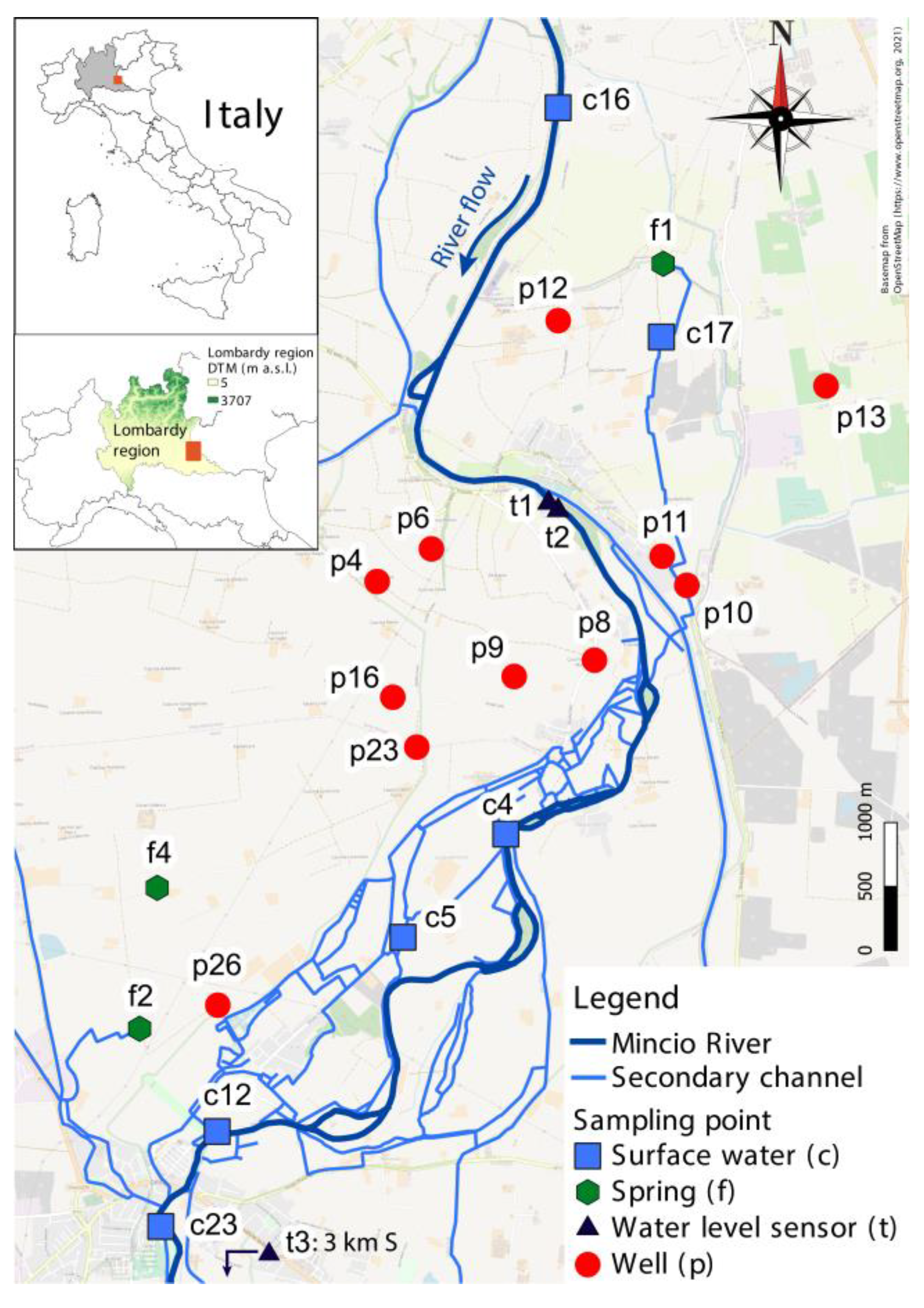

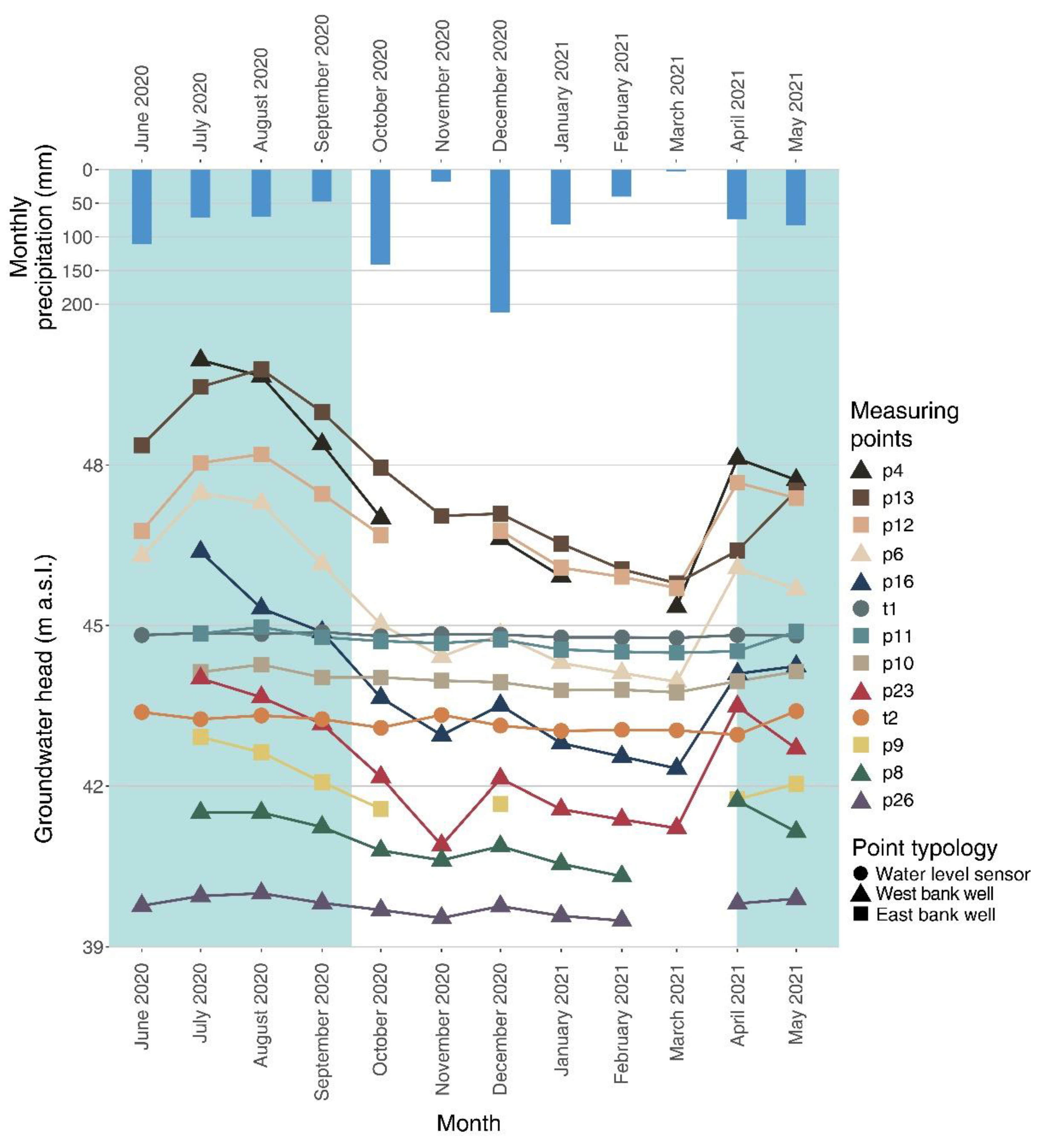
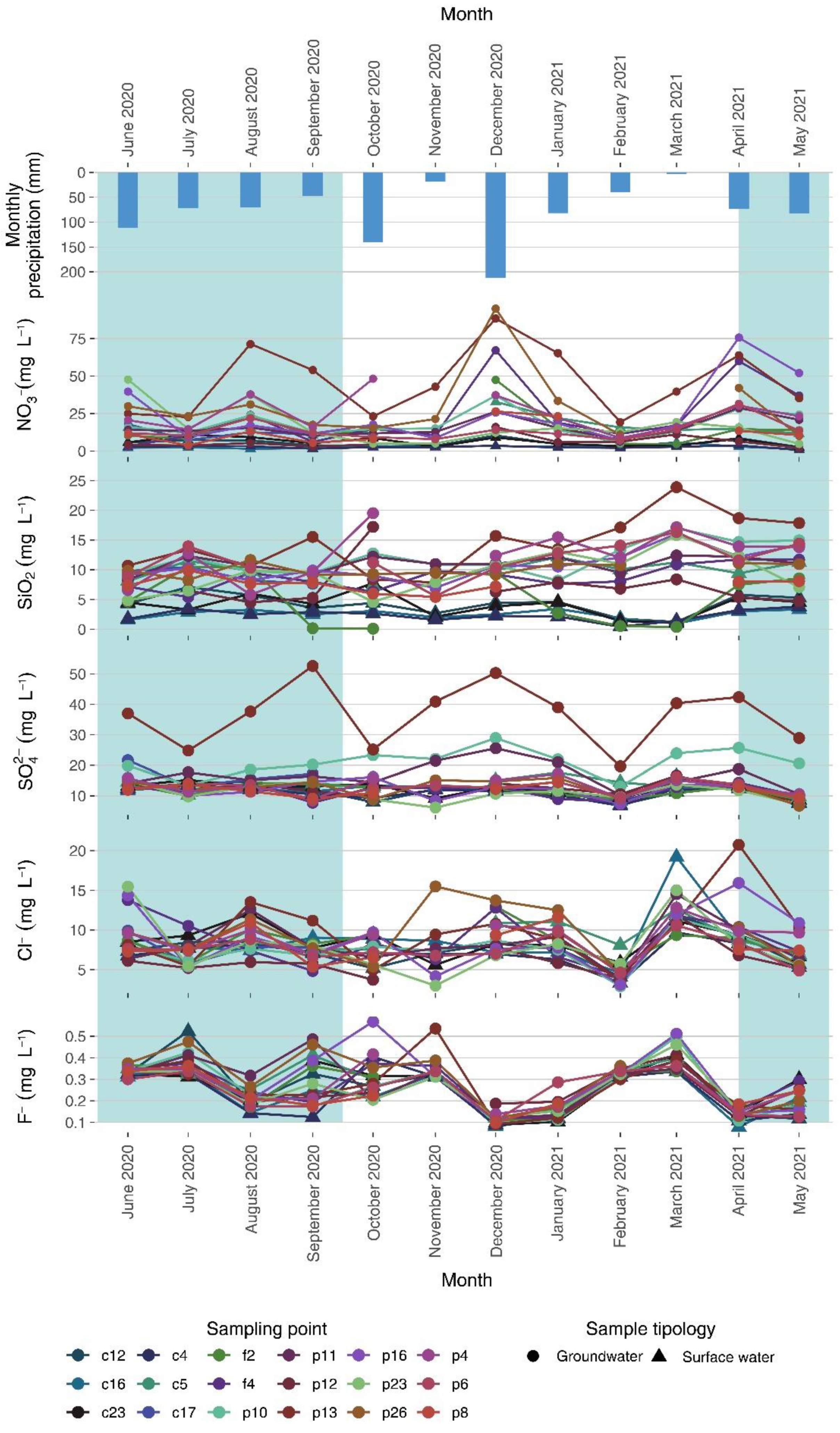
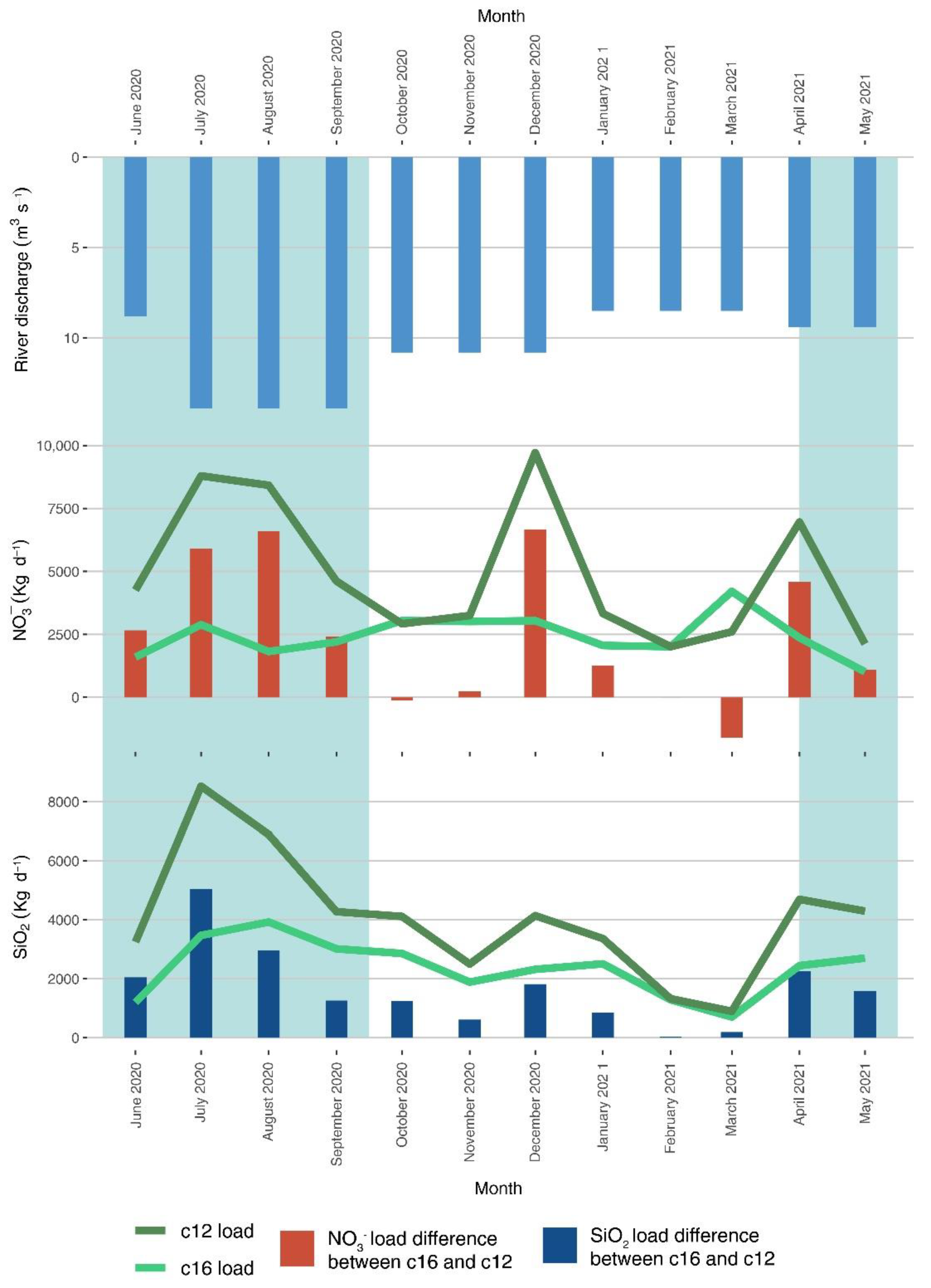
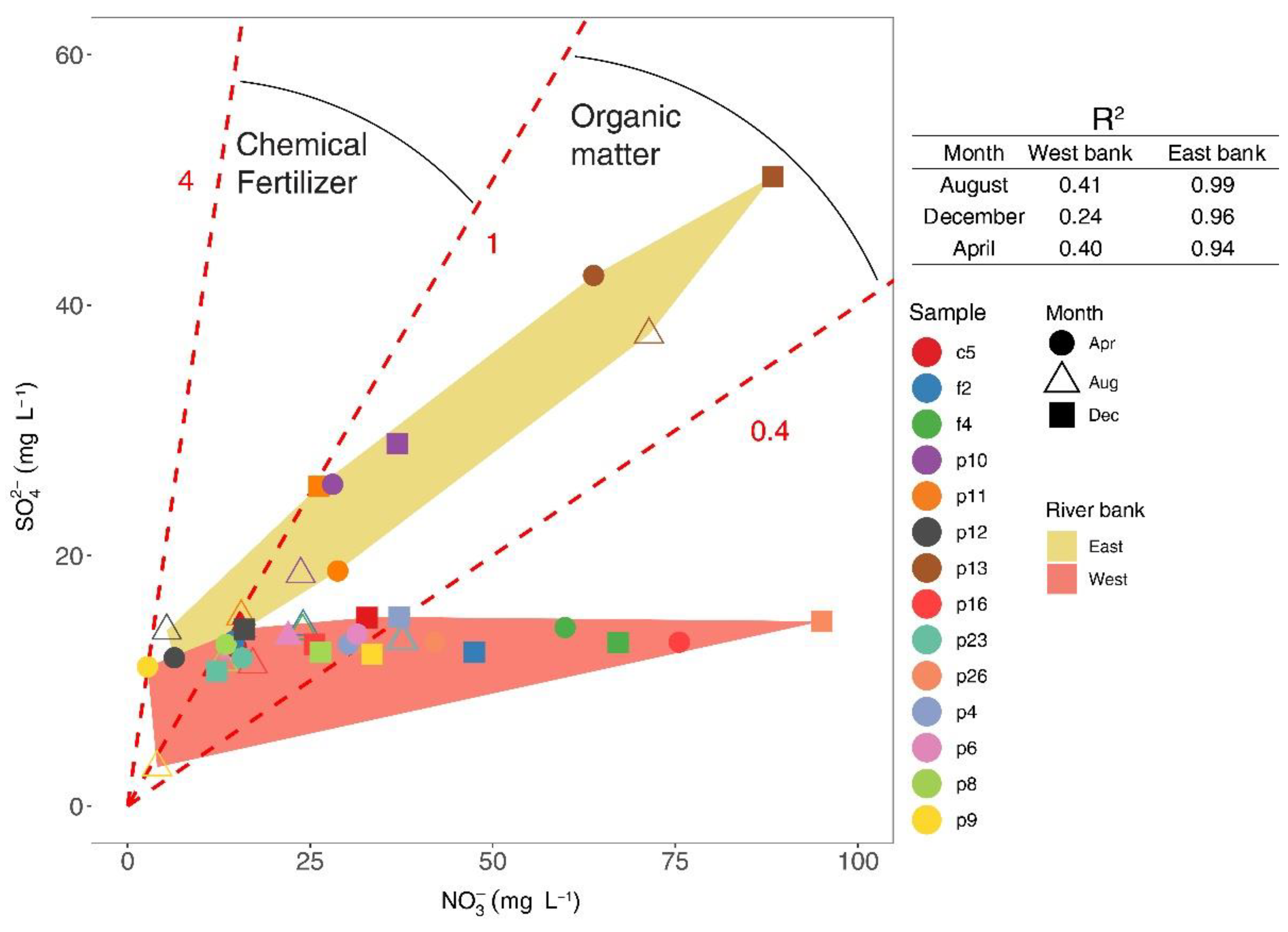
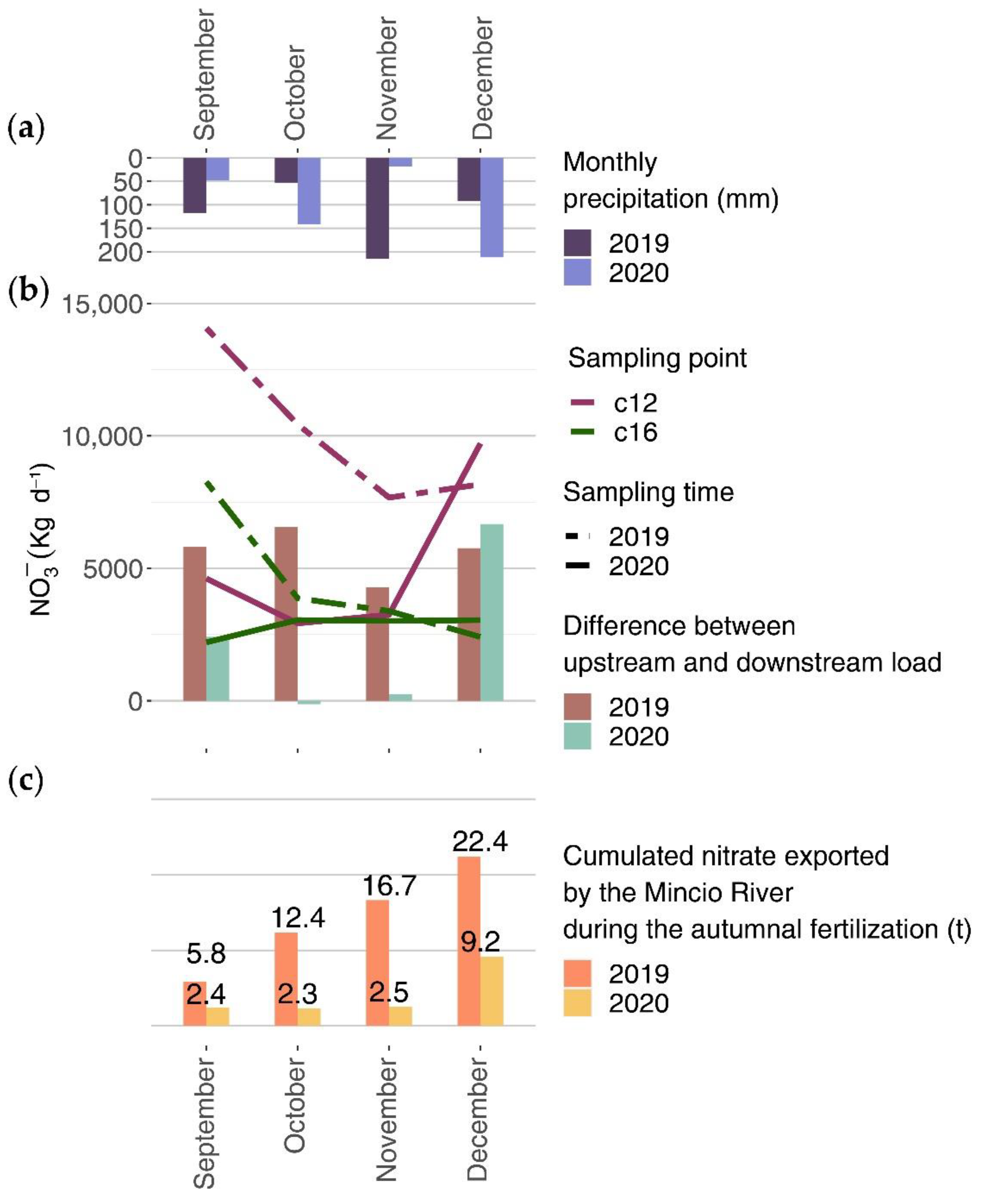
| Parameter | Median | Std Dev |
|---|---|---|
| t (°C) | 17.43 | 3.47 |
| EC (µS/cm) | 526 | 136 |
| pH | 7.48 | 0.32 |
| F− | 0.280 | 0.110 |
| Cl− | 7.792 | 2.816 |
| NO3− | 12.072 | 15.977 |
| SO42− | 12.918 | 7.002 |
| HCO3− | 257.436 | 63.613 |
| Na+ | 7.111 | 1.076 |
| K+ | 2.108 | 2.295 |
| Mg2+ | 15.199 | 4.151 |
| Ca2+ | 81.978 | 22.549 |
| SiO2 | 8.470 | 4.374 |
| Month | River Flow | c12 | c16 | Difference | |
|---|---|---|---|---|---|
| NO3− | m3 s−1 | mg L−1 | mg L−1 | kg d−1 | |
| June 2020 | 8.8 | 5.603 | 2.104 | 2660 | |
| July 2020 | 13.9 | 7.321 | 2.401 | 5908 | |
| August 2020 | 13.9 | 7.011 | 1.516 | 6599 | |
| September 2020 | 13.9 | 3.843 | 1.835 | 2411 | |
| October2020 | 10.8 | 3.13 | 3.268 | −129 | |
| November 2020 | 10.8 | 3.483 | 3.228 | 237 | |
| December 2020 | 10.8 | 10.412 | 3.263 | 6670 | |
| January 2021 | 8.5 | 4.534 | 2.806 | 1269 | |
| February 2021 | 8.5 | 2.741 | 2.741 | 0 | |
| March 2021 | 8.5 | 3.546 | 5.73 | −1604 | |
| April 2021 | 9.4 | 8.567 | 2.912 | 4593 | |
| May 2021 | 9.4 | 2.613 | 1.252 | 1106 | |
| SiO2 | June 2020 | 8.8 | 4.275 | 1.579 | 2050 |
| July 2020 | 13.9 | 7.099 | 2.892 | 5052 | |
| August 2020 | 13.9 | 5.736 | 3.27 | 2961 | |
| September 2020 | 13.9 | 3.562 | 2.512 | 1261 | |
| October2020 | 10.8 | 4.411 | 3.066 | 1255 | |
| November 2020 | 10.8 | 2.682 | 2.024 | 614 | |
| December 2020 | 10.8 | 4.44 | 2.488 | 1822 | |
| January 2021 | 8.5 | 4.581 | 3.415 | 856 | |
| February 2021 | 8.5 | 1.805 | 1.755 | 36.5 | |
| March 2021 | 8.5 | 1.223 | 0.961 | 193 | |
| April 2021 | 9.4 | 5.783 | 3.014 | 2250 | |
| May 2021 | 9.4 | 5.291 | 3.329 | 1593 |
| Year | Sample | Value | September | October | November | December |
|---|---|---|---|---|---|---|
| 2019 | c12 | Concentration | 11.717 | 11.180 | 8.220 | 8.755 |
| c16 | Concentration | 6.882 | 4.147 | 3.629 | 2.581 | |
| Difference | Load | 5807 | 6563 | 4284 | 5761 | |
| 2020 | c12 | Concentration | 3.843 | 3.130 | 3.483 | 10.412 |
| c16 | Concentration | 1.835 | 3.268 | 3.228 | 3.263 | |
| Difference | Load | 5807 | 6563 | 4284 | 5761 |
Publisher’s Note: MDPI stays neutral with regard to jurisdictional claims in published maps and institutional affiliations. |
© 2022 by the authors. Licensee MDPI, Basel, Switzerland. This article is an open access article distributed under the terms and conditions of the Creative Commons Attribution (CC BY) license (https://creativecommons.org/licenses/by/4.0/).
Share and Cite
Severini, E.; Bartoli, M.; Pinardi, M.; Celico, F. Short-Term Effects of the EU Nitrate Directive Reintroduction: Reduced N Loads to River from an Alluvial Aquifer in Northern Italy. Hydrology 2022, 9, 44. https://doi.org/10.3390/hydrology9030044
Severini E, Bartoli M, Pinardi M, Celico F. Short-Term Effects of the EU Nitrate Directive Reintroduction: Reduced N Loads to River from an Alluvial Aquifer in Northern Italy. Hydrology. 2022; 9(3):44. https://doi.org/10.3390/hydrology9030044
Chicago/Turabian StyleSeverini, Edoardo, Marco Bartoli, Monica Pinardi, and Fulvio Celico. 2022. "Short-Term Effects of the EU Nitrate Directive Reintroduction: Reduced N Loads to River from an Alluvial Aquifer in Northern Italy" Hydrology 9, no. 3: 44. https://doi.org/10.3390/hydrology9030044
APA StyleSeverini, E., Bartoli, M., Pinardi, M., & Celico, F. (2022). Short-Term Effects of the EU Nitrate Directive Reintroduction: Reduced N Loads to River from an Alluvial Aquifer in Northern Italy. Hydrology, 9(3), 44. https://doi.org/10.3390/hydrology9030044









